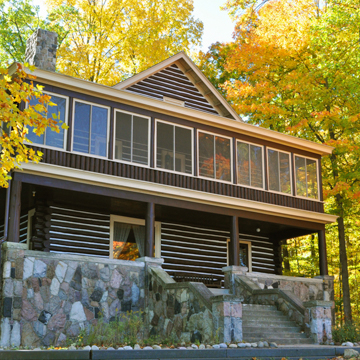You are here
Gene Stratton-Porter State Historic Site
When the Limberlost Swamp near Geneva, Indiana, began to disappear in the 1910s, Gene Stratton-Porter (1863–1924), by that time a very popular author of nature writings and novels, cast about for another location to live and work. Limberlost, a huge wetland where Stratton-Porter had been researching and documenting the habits of birds and insects for over 20 years, was gradually being drained, mined, and developed for farmland. She turned to an area that she had known well as a young woman, the shores of Sylvan Lake at Rome City, over 65 miles north. The author had consulted with an architect to plan the Geneva house, known as the Limberlost Cabin, but its shortcomings had become apparent as Stratton-Porter expanded her work into photography and close-hand study and documentation of moths and birds.
After renting a cottage on the north side of Sylvan Lake for a year, Stratton-Porter found just the right property for her new residence on a bluff on the lake’s south shore. She designed the fourteen-room rustic house with ample space for a library, a darkroom, and workroom. Completed in 1914, the gabled building’s exterior walls are white cedar logs from Wisconsin. A large open porch walled with a variety of rocks overlooks the lake; above it is an enclosed sleeping porch, believed at the time to promote healthful slumber. Inside, the entrance foyer and the dining room are paneled with locally harvested wild cherry. Each of the three fireplaces on the first floor is different: one includes Native American artifacts collected by her husband, Charles; another features puddingstone; and a third is of polished English brick, no doubt an expression of her pride in her paternal British heritage. The latest appliances and conveniences of the day filled the spacious kitchen, which included plenty of built-in cabinetry.
Stratton-Porter intended to live out her days in the house she called Limberlost North, and sometimes the “Cabin at Wildflower Woods.” With her own hands (and the help of her gardener) she had transplanted three thousand native plants into the woods on her property and created a colorful formal garden just outside the house. But winters were brutal, and by 1919 Stratton-Porter sought a part-time home in California. So taken was she with the year-round warm weather and the camaraderie in the artist colonies there, she ultimately decided to remain.
Today the house and its 148 acres form the Gene Stratton-Porter State Historic Site. The house, now maintained by the Gene Stratton-Porter Society, has been restored to the period in which Stratton-Porter occupied it. Much of the furniture and personal items within, including the contents of the library, are original.
References
Gross, Thomas, “Gene Stratton-Porter Cabin,” Noble County, Indiana. National Register of Historic Places Registration Form 1974. National Park Service, U.S. Department of the Interior, Washington, D.C.
Writing Credits
If SAH Archipedia has been useful to you, please consider supporting it.
SAH Archipedia tells the story of the United States through its buildings, landscapes, and cities. This freely available resource empowers the public with authoritative knowledge that deepens their understanding and appreciation of the built environment. But the Society of Architectural Historians, which created SAH Archipedia with University of Virginia Press, needs your support to maintain the high-caliber research, writing, photography, cartography, editing, design, and programming that make SAH Archipedia a trusted online resource available to all who value the history of place, heritage tourism, and learning.








